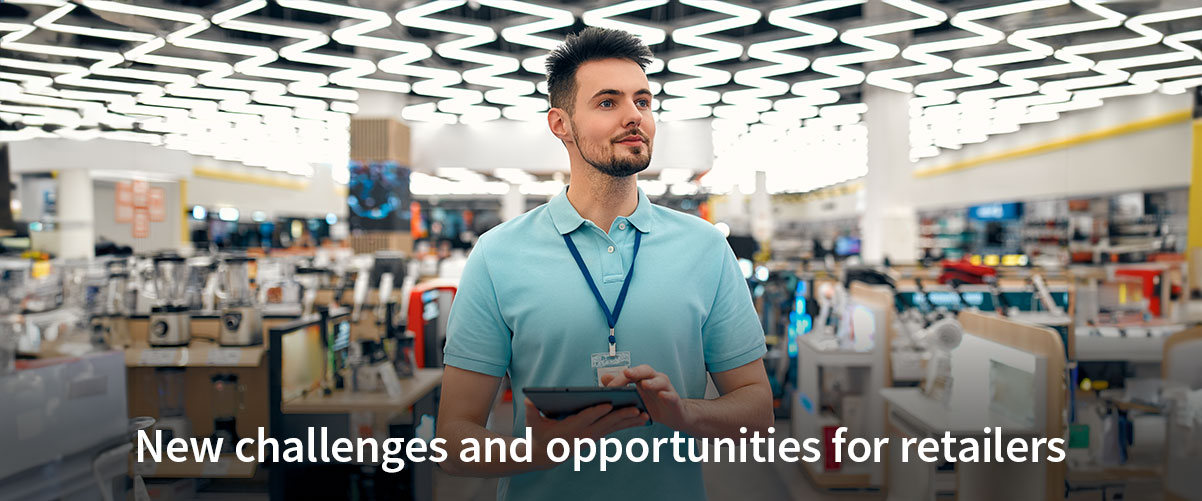
Welcome back to Part 2 of “6 Disruptive Forces that are Creating New Challenges and Opportunities for Retailers.” In Part 1, we explored the 3 disruptives and how they are shaping the future of retail. Now, let’s delve into the remaining three.
4. Escalating Prioritization of Sustainability
Sustainability has become a top priority for consumers, businesses, and policymakers. Retailers are facing increasing pressure to adopt sustainable practices and demonstrate their commitment to environmental and social responsibility. Key trends include:
- Supply chain transparency: Consumers demand transparency into the supply chains of the products they purchase, ensuring ethical and sustainable sourcing.
- Decarbonization: Retailers are under pressure to reduce their carbon footprint and transition to renewable energy sources.
- Human rights & DEI: Ensuring human rights and promoting diversity, equity, and inclusion (DEI) are becoming essential for retailers.
- Plastic packaging: Reducing plastic waste and promoting sustainable packaging solutions is a growing concern.
- Circularity: Retailers are exploring circular economy models to minimize waste and extend product lifecycles.
- Food waste: Reducing food waste throughout the supply chain is a key sustainability challenge.
- Consumer health: Consumers are increasingly concerned about the health and safety of products, leading to stricter regulations and labeling requirements.
- Biodiversity: Protecting biodiversity and minimizing the environmental impact of retail operations is essential.
- Resource intensity: Retailers are under pressure to reduce their consumption of natural resources.
70% of consumers feel companies should drive positive ESG outcomes
Imperatives for Retailers
To address these sustainability challenges, retailers must:
- Build end-to-end supply chain transparency to ensure ethical and sustainable sourcing.
- Develop circular processes to minimize waste and extend product lifecycles.
- Create alliances with peers to share best practices and collaborate on sustainability initiatives.
- Prioritize material issues, such as plastic reduction and sustainable packaging.
- Measure and report their environmental and social impact to demonstrate accountability.
- Educate consumers on how to use and dispose of products sustainably.
- Optimize stakeholder communications to build trust and transparency.
- Operationalize their ESG strategy to integrate sustainability into all aspects of their business.
- Explore alternative suppliers that prioritize sustainability and ethical practices.
5. Rising Political & Economic Uncertainty
The global political and economic landscape is increasingly volatile, creating uncertainty for retailers. Key trends include:
- Geopolitical conflict: Geopolitical tensions and conflicts can disrupt supply chains and increase costs.
- Rising trade tensions: Trade wars and tariffs can impact the cost of goods and create uncertainty for businesses.
- Uneven vaccinations: The global distribution of vaccines and the emergence of new variants can impact economic recovery and consumer confidence.
- Inflation and energy costs: Rising inflation and energy costs can increase operating costs for retailers.
- Debt and interest rates: High debt levels and rising interest rates can create financial challenges for businesses.
- Supply chain disruption: Disruptions in supply chains due to geopolitical events, natural disasters, or other factors can impact product availability and costs.
- Unemployment: Rising unemployment can reduce consumer spending and create economic uncertainty.
- Cybersecurity breaches: The risk of cybersecurity breaches is increasing, posing a threat to businesses and consumers.
- Political polarization: Political polarization can create a challenging environment for businesses and make it difficult to navigate regulatory changes.
60% of consumers are worried that war will spread globally
Imperatives for Retailers
To mitigate these risks, retailers must:
- Build local supplier networks to reduce reliance on global supply chains and mitigate the impact of geopolitical events.
- Hedge for cost spikes by implementing strategies to manage price fluctuations and protect profit margins.
- Diversify global logistics to reduce the risk of disruptions and ensure a reliable supply of products.
- Assess geopolitical scenarios to anticipate potential risks and develop contingency plans.
- Impose price guarantees to maintain customer loyalty and mitigate the impact of rising costs.
- Simplify in-store assortments to focus on essential products and reduce inventory costs.
- Reduce fossil energy reliance to mitigate the impact of rising energy costs and support sustainability goals.
- Tighten data encryption to protect sensitive customer data and mitigate the risk of cybersecurity breaches.
- Restructure debt burden to improve financial stability and reduce the impact of rising interest rates.
6. Blurring Lines Between Sectors and Channels
The boundaries between sectors and channels are blurring, creating new opportunities for retailers to expand their offerings and reach new customers. Key trends include:
- Consumers as products: Retailers are increasingly leveraging customer data to provide personalized experiences and sell targeted products and services.
- From product to service: Retailers are transitioning from selling products to providing services, such as subscription models and personalized recommendations.
- Retailtainment: Retailers are combining retail with entertainment to create immersive and engaging experiences.
- Immersive experiences: Retailers are leveraging technologies like augmented reality (AR) and virtual reality (VR) to create immersive shopping experiences.
- End-to-end engagement: Retailers are striving to provide a seamless customer experience across all channels, from online to in-store.
- Bundled solutions: Retailers are offering bundled solutions that combine products and services to meet the needs of customers.
- Self-healthcare: Retailers are expanding into self-healthcare products and services, such as wellness products and virtual consultations.
- Gamification: Retailers are incorporating gamification elements into their shopping experiences to engage customers and drive sales.
- Selling data: Retailers are exploring new opportunities to monetize customer data, such as targeted advertising and market research.
44% of consumers intend to spend more on experiences
Imperatives for Retailers
To capitalize on these trends, retailers must:
- Expand the scope of their ecosystem to include a wider range of products and services.
- Increase the range of services they offer to meet the evolving needs of customers.
- Group products with services to create bundled solutions and increase customer value.
- Explore sector adjacencies to identify new growth opportunities.
- Leverage alternative models such as subscription services and rental options.
- Identify B2B value pools to expand their customer base and revenue streams.
- Build a retail media presence to reach new customers and monetize their audience.
- Develop digital-first offerings to meet the needs of digital-savvy consumers.
- Create in-store experiences that are engaging and memorable.
The retail industry is facing a complex and challenging landscape, shaped by evolving consumer behaviors, rapidly changing technologies, increasing tax & regulatory complexity, escalating sustainability priorities, rising political & economic uncertainty, and blurring lines between sectors and channels. Retailers that can successfully navigate these disruptive forces will be well-positioned for long-term success. By understanding these trends and implementing appropriate strategies, retailers can adapt to the changing landscape and thrive in the future.



